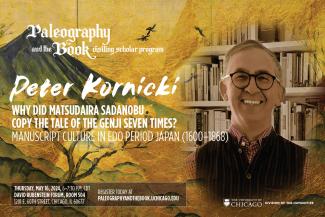Visiting Scholar Peter Kornicki (2024) to present the Paleography and the Book Lecture 2024

Presenter: Renowned Scholar Peter Kornicki
May 16, 2024
6 to 7:30 p.m. CDT
Paleography and the Book Lecture
David Rubenstein Forum, Room 504, 1201 E. 60th Street, Chicago, IL 60637
Introduction by: Hoyt Long, Chair and Professor in the Department of East Asian Languages and Civilizations and the College and Interim Director of the Japanese Language Program
Q&A Moderator: Chelsea Foxwell, Associate Professor in the Departments of Art History and East Asian Languages and Civilizations and the College
Matsudaira Sadanobu (1759–1829), who was the de facto ruler of Japan from 1787 to 1793, copied out by hand the Tale of Genji seven times and could not remember how many times he had copied out the Tales of Ise. These classic works of Japanese literature had already appeared in many printed editions by 1700. Certainly, Sadanobu had the means and the opportunity to acquire as many copies as he wanted. So why did he copy them out multiple times?
The story of Sadanobu’s copying activities contradicts the image of the Edo period (1600–1868) as the age in which commercial printing took off in Japan. It was during the Edo period that printed books were profusely illustrated by the most famous artists of their day, that they reproduced the fine calligraphy of manuscript originals, and that they spread to all corners of Japan.
But if that was the case, there are some difficult questions to answer. Why did Sadanobu undertake all that copying? Why did so many people copy out printed books? Why was so much knowledge confined to manuscripts, including the discovery of anesthesia? Why did some of the most popular works of fiction circulate only in manuscript? There was another side to the history of the book in Japan, one that consists of manuscripts rather than printed books.
Japanese manuscript expert Peter Kornicki will bring some manuscripts from his own collection for inspection after the Paleography and the Book Lecture 2024, but his focus will be on exposing the underworld of manuscript books dealing with secret knowledge, shocking scandals, and obscure rituals.
Past lectures
Safety and parking
